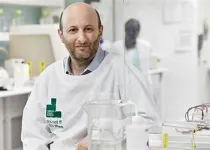(Press-News.org) · Major advance for treatment of deadly brain cancer
· Clinical trial launched at Northwestern to test treatment
· Ultrasound microbubbles open blood-brain barrier to admit chemotherapy and immunotherapy cocktail
CHICAGO --- In a major advance for the treatment of the deadly brain cancer glioblastoma, Northwestern Medicine scientists used ultrasound technology to penetrate the blood-brain barrier and provide a small dose of a chemotherapy and immunotherapy drug cocktail. The study found that this treatment boosted the immune system’s recognition of the cancer cells and could lead to a new treatment approach.
The scientists made several breakthroughs reported in a new study to be published in Nature Communications this Thursday, June 6.
Scientists showed for the first time that a skull-implantable ultrasound device can enhance the penetration of the chemotherapy drug doxorubicin and immune checkpoint blockade antibodies — a novel immunotherapy treatment combination — into the human brain. The device produces microbubbles that temporarily open the blood-brain barrier, allowing the immunotherapy to enter the brain.
The scientists also showed for the first time that a small dose of doxorubicin (smaller than the dose used for traditional chemotherapy regimens) delivered with the immune checkpoint antibodies can boost the recognition of malignant glioblastoma cells by the immune system and reinvigorate the lymphocytes (immune cells) that are in charge of attacking the cancer cells.
An immune checkpoint blockade antibody blocks the deactivation of the immune system by the cancer cells. The immune system has built-in brakes — called immune checkpoints — so it doesn’t overdo it and injure the body when attacking cancer and infections. Glioblastoma evolves to activate the brakes, and therefore, the immune system (i.e., lymphocytes) won’t attack it.
In addition to the tumor cells, glioblastoma contains other cell populations called macrophages and microglia. These are the most abundant components of the tumor microenvironment and the cells that glioblastoma modulates to inhibit lymphocytes. The study showed that the chemo and antibody cocktail altered these cells, enabling the lymphocytes to recognize and kill the cancer cells.
“This is the first report in humans where an ultrasound device has been used to deliver drugs and antibodies to glioblastoma to change the immune system, so it can recognize and attack the brain cancer,” said co-corresponding author Dr. Adam Sonabend, associate professor of neurological surgery at Northwestern University Feinberg School of Medicine and a Northwestern Medicine neurosurgeon. “This could be a major advance for the treatment of glioblastoma, which has been a frustratingly difficult cancer to treat, in part due to poor penetration of circulating drugs and antibodies into the brain.”
The study was conducted in four patients who had advanced progression of their tumors. They had already been treated with conventional chemotherapy for their tumors as well as an experimental treatment in a clinical trial, but both times, the tumors returned.
“This is a great example of translational bench-to-bedside-back-to-bench research, which sets an exceptional scenario to learn about the ability of the immune system to kill brain tumors in real-time upon treatment,” said co-corresponding author Catalina Lee-Chang, assistant professor of neurological surgery at Northwestern University Feinberg School of Medicine. “Given the lack of effective immune response against these deadly tumors, these findings encourage us to envision a potential new treatment approach.”
Clinical trial launched with new treatment
These new findings are the basis for a novel clinical trial that was just launched at Northwestern using the ultrasound to deliver the immunotherapy for glioblastoma. The trial will initially enroll 10 participants to determine the safety of the treatment, followed by 15 additional to measure whether the treatment can prolong survival.
Previous large clinical trials have failed to show that this type of immunotherapy can prolong survival in glioblastoma patients. Sonabend, however, believes that by enhancing the delivery of these antibodies and drugs into the brain and relying on biomarkers that indicate which tumors are most susceptible to immunotherapy, this treatment might be shown to be effective for some glioblastoma patients.
“Here we show in a small cohort of patients that when you use this technology, you can enhance the delivery of the chemotherapy and the antibodies, and change the tumor’s microenvironment, so the immune system can recognize the tumor,” Sonabend said.
Sonabend and Lee-Chang are members of the Robert H. Lurie Comprehensive Cancer Center of Northwestern University and the Malnati Brain Tumor Institute. Sonaband also is director of translational neuro-oncology at Feinberg.
The title of the article is “Ultrasound-mediated delivery of doxorubicin to the brain results in immune modulation and improved responses to PD-1 blockade in gliomas.”
Other Northwestern authors include first author Víctor A. Arrieta, Andrew Gould, Kwang-Soo Kim, Karl J. Habashy, Crismita Dmello, Gustavo I. Vázquez-Cervantes, Irina Palacín-Aliana, Graysen McManus, Christina Amidei, Cristal G. Gomez, Silpol Dhiantravan, Li Chen, Daniel Y. Zhang, Ruth Saganty, Meghan E. Cholak, Surya Pandey, Matthew McCord, Kathleen McCortney, Brandyn Castro, Rachel Ward, Bin Zhang, Jason M. Miska, Maciej S. Lesniak, Craig M. Horbinski, Rimas V. Lukas and Roger Stupp.
The research was supported in part by the National Cancer Institute grants 1R01NS110703-01A1, 1U19CA264338-01 and 1R01CA245969-01A1 of the National Institutes of Health, grant P50CA221747 SPORE for Translational Approaches to Brain Cancer and the Moceri Family Foundation and the Panattoni family.
###
A.M. Sonabend and R. Stupp have received funding support for research from Agenus, BMS, and Carthera. Sonabend, Arrieta, Kim, Amidei, and Stupp are co-authors of an IP filed by Northwestern University related to the content of this manuscript. (PCT/US2023/034299). Sonabend has served as a consultant for Carthera and EnClear Therapies. Stupp has acted or is acting as a scientific advisor or has served on advisory boards for the following companies: Alpheus Medical, AstraZeneca, Boston Scientific, Carthera, Celularity, GT Medical, Insightec, Lockwood (BlackDiamond), Northwest Biotherapeutics, Novocure, Inc., Syneos Health (Boston Biomedical), TriAct Therapeutics, Varian Medical Systems. C. Desseaux, G. Bouchoux, and M. Canney are employees and hold an ownership interest in Carthera. M. Canney, G. Bouchoux, and A. Carpentier have patents related to the ultrasound technology described herein. R. Stupp is an advisory member and consultant for Carthera. A. Carpentier is a consultant for Carthera. C. Lee-Chang is a co-founder and consultant for Sera BioPharma
END
New glioblastoma treatment reaches human brain tumor and helps immune cells recognize cancer cells
Novel immunotherapy is first-in-human treatment for this brain cancer
2024-06-06
ELSE PRESS RELEASES FROM THIS DATE:
Using oceanography to understand fronts and cyclones on Jupiter
2024-06-06
New research led by Lia Siegelman, a physical oceanographer at UC San Diego’s Scripps Institution of Oceanography, shows that the roiling storms at the planet Jupiter’s polar regions are powered by processes known to physicists studying Earth’s oceans and atmosphere. The geophysical commonalities spanning the 452 million miles between the two planets could even help facilitate an improved understanding of those processes on Earth.
Siegelman first made the connection between our planet and the gas giant in 2018 when she noticed a striking similarity between images of Jupiter’s huge cyclones and the ocean turbulence she was studying. ...
Ohio State develops searchable database for Alzheimer’s research
2024-06-06
COLUMBUS, Ohio – A searchable database is now ready to help study Alzheimer’s disease.
Neuroscience and biomedical informatics researchers at The Ohio State University Wexner Medical Center and College of Medicine created the comprehensive, user-friendly repository.
The free database – known as ssREAD – is outlined in a manuscript published online in Nature Communications.
Alzheimer’s disease is the most common cause of dementia, accounting for up to 80% of cases. An estimated 6.7 million Americans who are age 65 and older are living with Alzheimer's dementia today, according ...
Lifesaving childbirth blood loss intervention is highly cost-effective
2024-06-06
Economic analysis of the E-MOTIVE trial finds that average cost per patient of drape and treatment to save women’s lives incurs minimal additional cost compared with usual care, while significantly improving health outcomes.
The additional cost to achieve the improved outcome could be as little as 30 US cents extra- on average, compared to usual care.
Post-partum haemorrhage currently affects 14m women around the world and leads to 70,000 deaths a year which is equivalent to one woman dying every 6 minutes
A lifesaving package including early detection and bundled treatment for ...
Hidden challenges of tooth loss and dentures revealed in new study
2024-06-06
The hidden challenges faced by people with tooth loss and dentures has been identified by new research from the University of Sheffield.
Improvements in dental care, more people living longer and the social value placed on having a healthy smile has led to people keeping their own teeth longer, but it has also led to an increasing number of people needing some kind of restoration work including crowns, bridges and implants.
Many of these treatments remain unobtainable for most people due to the availability of NHS dentists and the high cost of private dental work. Removable dentures are often the only viable option for anyone experiencing tooth loss with an estimated ...
How medical models can transform agriculture
2024-06-06
Nano-agriculture: Sustainable solutions for global food security
PITTSBURGH—Researchers in the Department of Civil and Environmental Engineering at Carnegie Mellon University are using findings from nanomedicine and digital twin technologies to understand the new field of Plant Nanobiotechnology, address unsustainable agricultural practices, and meet increasing global food demands.
Currently, agriculture accounts for 14-28% of global greenhouse gas emissions and 70% of all freshwater withdraws. This, in addition to a range of other factors from extreme weather ...
World-first study into precision medicine for high-risk childhood cancer yields extraordinary results
2024-06-06
WORLD-FIRST STUDY INTO PRECISION MEDICINE FOR HIGH-RISK CHILDHOOD CANCER YIELDS EXTRAORDINARY RESULTS
VIDEO - https://www.youtube.com/watch?v=bwyugwVwNzc
In a world-first, Australian researchers and clinicians have shown that precision medicine – where treatment is tailored to an individual child’s cancer – leads to significantly improved outcomes in children with high risk cancer.
In a study published this week in the leading international journal Nature Medicine, the researchers found that precision medicine (also called personalised medicine) was shown to be superior to standard or non-guided therapy, both in terms of clinical response and survival.
A staggering ...
Better farming through nanotechnology
2024-06-06
Advanced technologies enable the controlled release of medicine to specific cells in the body. Scientists argue these same technologies must be applied to agriculture if growers are to meet increasing global food demands.
In a new Nature Nanotechnology journal review paper, scientists from UC Riverside and Carnegie Mellon University highlight some of the best-known strategies for improving agriculture with nanotechnology.
Nanotechnology is an umbrella term for the study and design of microscopically small things. How small? A nanometer is one billionth of a meter, or about 100,000 times smaller ...
First-of-its-kind test can predict dementia up to nine years before diagnosis
2024-06-06
Peer Reviewed | Observational study | People
Researchers at Queen Mary University of London have developed a new method for predicting dementia with over 80% accuracy and up to nine years before a diagnosis. The new method provides a more accurate way to predict dementia than memory tests or measurements of brain shrinkage, two commonly used methods for diagnosing dementia.
The team, led by Professor Charles Marshall, developed the predictive test by analysing functional MRI (fMRI) scans to detect changes in the brain’s ‘default mode network’ (DMN). The DMN connects regions of the brain ...
Popular chatbot is a politically left-leaning EU supporter
2024-06-06
With the European Parliament elections now underway, millions of EU citizens are finalizing their decisions about which political party best represents their views.
But anyone using LlamaChat, one of the major new AI chatbots, is very likely to be confronted with biased answers. It turns out that the large language model developed by Meta, upon which LlamaChat is based, has clear political leanings. This has been demonstrated in a new study from the University of Copenhagen in which Department of Computer Science researchers examined the language model's knowledge of political groups in the European Parliament. Moreover, they tested LlamaChat’s ...
Doctors advise caution as energy drinks may trigger life-threatening cardiac arrhythmias in patients with genetic heart diseases
2024-06-06
Philadelphia, June 6, 2024 – A new study in Heart Rhythm, the official journal of the Heart Rhythm Society, the Cardiac Electrophysiology Society, and the Pediatric & Congenital Electrophysiology Society, published by Elsevier, examined the potential dangers of consuming energy drinks for patients with genetic heart diseases. A cohort of 144 sudden cardiac arrest survivors was examined at Mayo Clinic, of which seven patients (5%) had consumed one or more energy drinks in close proximity to their cardiac ...
LAST 30 PRESS RELEASES:
University of Phoenix College of Doctoral Studies releases white paper on AI-driven skilling to reduce burnout and restore worker autonomy
AIs fail at the game of visual “telephone”
The levers for a sustainable food system
Potential changes in US homelessness by ending federal support for housing first programs
Vulnerability of large language models to prompt injection when providing medical advice
Researchers develop new system for high-energy-density, long-life, multi-electron transfer bromine-based flow batteries
Ending federal support for housing first programs could increase U.S. homelessness by 5% in one year, new JAMA study finds
New research uncovers molecular ‘safety switch’ shielding cancers from immune attack
Bacteria resisting viral infection can still sink carbon to ocean floor
Younger biological age may increase depression risk in older women during COVID-19
Bharat Innovates 2026 National Basecamp Showcases India’s Most Promising Deep-Tech Ventures
Here’s what determines whether your income level rises or falls
SCIE indexation achievement: Celebrate with Space: Science & Technology
Children’s Hospital Colorado performs region’s first pediatric heart and liver dual organ transplant
Australian team discover why quantum computers have memory problems over time
What determines the fate of a T cell?
Candida auris: genetic process revealed which could be treatment target for deadly fungal disease
Groundbreaking discovery turns household plastic recycling into anti-cancer medication
Blocking a key inflammatory pathway improves liver structure and vascular function in cirrhosis, study finds
Continuous spread: Raccoon roundworm detected in nine European countries
HKUST Engineering researchers developed a novel photodetector to enhance the performance of on-chip light monitoring
Strategic river sensors could have forewarned of Texas Camp flood disaster
Drone sampling of whale breath reveals first evidence of potentially deadly virus in Arctic
Roman soldiers defending Hadrian’s Wall infected by parasites, study finds
Pinochet’s prisoners were tormented with music but still found solace in it, a new book reveals
Fertility remains high in rural Tanzania despite access to family planning
AI-assisted device can improve autism care access
Kinetic careers
Uncovering how parasitic plants avoid attacking themselves to improve crop resistance
Nanoparticle vaccine strategy could protect against Ebola and other deadly filoviruses
[Press-News.org] New glioblastoma treatment reaches human brain tumor and helps immune cells recognize cancer cellsNovel immunotherapy is first-in-human treatment for this brain cancer




